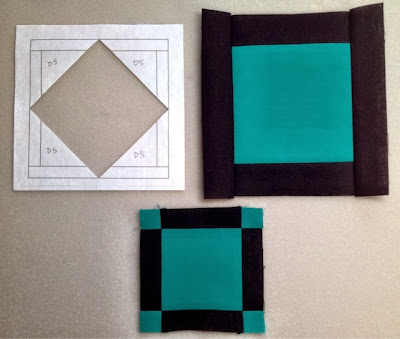Ever since I saw Doreen demonstrate this block in class I've been eagerly anticipating making this block. It fascinates me with its rays radiating from the center circle. This is my 51st block, the 4th from January's blocks, and I decided to see if I could make it in the hour or so I had before heading off to the February class.
Doreen did a great job of providing cutting instructions, taking care to note that half the rays are longer than the other half. She is so good at saving fabric when she gives cutting directions.
Although there are 17 pieces to this block, there are only two sections and one easy applique, so I hope it will sew up quickly.
Here is the difference between an unpressed seam and a pressed seam. In the unpressed seam there is a substantial curve of fabric that can be seen at the two ends of the seam--at least 1/8 inch of fabric billows out from the seam. If this is left unpressed, it will definitely affect the accuracy and how the pieced section finishes up.
Here is the pressed seam. Notice that you can see almost right down to the stitches in the seam. This is now an accurate seam and will not distort the layout of the pieced section. I used the wooden pressing stick edge to open up the seam.
Here are the two sections, mirror images of each other, not trimmed in any way. I'll trim only the straight edge that joins the two sections. The way Doreen set up the order of sewing ensures all the seams will flow in the same direction when the two sections are sewn together. I chose not to sew the seams down to the center point, because 7 seams meeting at the center would be very bulky. This area will be covered by the appliqued circle anyway.
I use two pins to line up the circle and seam intersections.
I use the Dear Jane square ruler to trim the outer edges. This ruler is the companion to the triangle ruler and is a MUST when making this quilt! I focus on the 4 points where the outer edge seams come together to line it up.
After years of avoiding and dreading anything involving applique, I now love it! I consistently use one of the several applique techniques Doreen taught us. It is totally reliable, avoiding all frustration, and uses wash-away fusible and basting glue. One other tool that makes it so easy are these tweezers that came with my Bernina 830 machine. The tips are angled just right to grab the tiny fabric pieces to pull over the fusible, then I use the flat edges to coax the folds into a smooth edge.
Here is the block ready for hand sewing the applique piece. What a terrific block--so wonderfully graphic--very symmetrical.
Here is the white quilt version. It occurred to me that it would be prudent to trim the block after appliqueing the center circle in order to avoid fraying. Also note that two of the tips are right at the edge of the fabric, testament to the necessity to line up the fabric pieces very carefully and test before sewing!
Completed blocks.
My next post will be about block C-13, the 'Lakota Sioux' block. This block looks complicated!









































.jpg)
.jpg)
.jpg)
.jpg)
.jpg)
.jpg)
.jpg)
.jpg)
.jpg)
